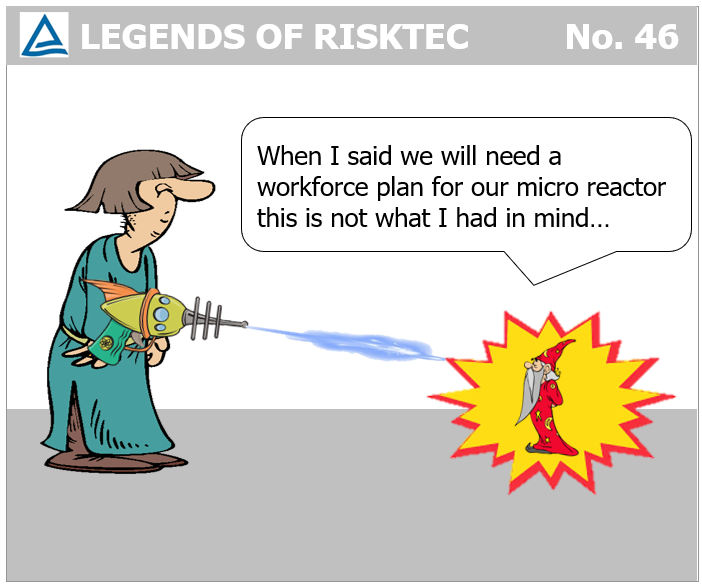Is the next big thing in nuclear really small? The rise of the microreactors
Although currently experiencing a revival, the concept of Small Modular Reactors (SMRs) is not a new idea with designs first emerging in the 1950s for a variety of uses. There is currently much interest in even smaller ‘microreactors’, but what are the features and design considerations associated with these?
INTRODUCTION
As the name suggests, SMRs are small nuclear reactors, which generally have a power capacity of up to 300 MW(e), approximately 2-4 times less than typical commercial size reactors.
An intriguing subset of new SMRS are the so-called microreactors which typically have a power capacity of up to a few tens of MW(e). Currently there are estimated to be more than 80 SMR designs in development, of which over 30 are microreactor projects (Figure 1).

Figure 1 – SMR designs in development globally (Ref. 1)
SMR DEVELOPMENT
A key driver for SMR development is the potential to have standardised, factory-fabricated modules which can be readily transported by truck, rail or even air transport to the site of deployment, although for larger SMRs on-site construction of a power station and surrounding infrastructure is still required. For microreactors the potential for the whole reactor system to be factory fabricated, transported to a deployment site and ‘plugged-in’ as required exists.
Hence microreactors promise shorter and more efficient construction periods and flexible installation which can be expanded with more units added if more power is needed. Some of their potential uses are to provide heat or power to remote communities or industrial applications including sea water desalination, hydrogen production or steel making.
Some designers are considering their use as transportable power ‘batteries’, for example for deployment to disaster-hit areas or to provide carbon-free load support to intermittent renewable generation. Most recently, the use of microreactors to power AI data centres (Figure 2) has hit the headlines as an early potential use of such reactors. However, to enable this future for microreactors, there are some key challenges.

Figure 2 – Data centre
DESIGN BASICS
Whereas many (but not all) of the initial wave of SMR designs are based on established reactor designs (e.g. pressurised water reactors or boiling water reactors) albeit often with enhanced passive safety systems, the majority of microreactor designs are at the vanguard of the next generation of what are termed ‘advanced reactors’.
Many of these advanced microreactor designs shift the dial in terms of their fuel, cooling technology, control requirements and safety philosophy. For example, many microreactors are proposing to use higher enrichment fuel than standard designs. Some propose to use robust ceramic-encapsulated fuel pellets which are resilient to failing in accident scenarios.
When it comes to heat removal and emergency cooling, we start to see real differences from traditional nuclear designs. Systems based on helium cooling are common due to its low corrosive properties, low neutron absorption and high thermal conductivity, but other systems are under active consideration, including molten salt and liquid metal coolants.
Emergency heat removal is often based on passive systems, for example air convection systems which are either ‘always-on’ or which are initiated by passive means (e.g. melting a sacrificial plug to initiate the system).
SAFETY DESIGN
From a safety perspective, and to achieve ‘walk away safe’, microreactors make extensive use of inherent and passive safety characteristics. Designs make use of significant negative temperature feedback characteristics for reactivity, meaning their power is modulated by their physical characteristics with substantial margins against reactivity insertion hazards. Many designs claim that decay heat can be passively removed from the reactor without the need for active systems and, importantly, without the need for electrical power supplies. Where transportability isn’t necessary, many designs are planned to be located in robust underground bunkers which give protection against external hazards.
As SMRs may be located in more remote sites than traditional reactors, additional Unattended Remote Monitoring Systems (USMRs) may also be employed to provide an additional layer of defence and may also be of significant benefit due to their data generation, collection and transmission capabilities.
SECURITY AND SAFEGUARDS
An interesting area to consider is how the security of a microreactor can be assured given their potential uses and their possible remote locations.
Now, more than ever, the principle of ‘security by design’ is key to project success. This principle requires that the designer seeks to design out security risks and vulnerabilities rather than taking a more traditional approach of adding active protection such as security systems or providing a response to incidents. Clearly, the more that can be done to ensure the inherent security of the design, the better to achieve the potential benefits of this class of reactors.
Although advantages may exist in the use of remote monitoring (or even control) of facilities in distant locations, this will require consideration from a cyber security perspective.
KEY CHALLENGES
As an exciting and rapidly developing field which is pushing the traditional approach to reactor design, microreactors will face some future challenges.
Some of these challenges are familiar to us; for example the development of a suitable safety case for the reactor to support licensing and operations. For application to microreactors, this may require new methodologies and guidance, particularly where novel features or new approaches are being proposed, for example in the assurance of passive safety systems, reduced on-site manning levels or incident response. Such features will provide a challenge both to designers and regulators.
As we have seen, microreactors could be deployed in a wide range of locations and on a variety of different sites. For example, a facility could be required in a remote community in the arctic tundra, an earthquake zone (e.g. to support disaster relief) or as part of an industrial complex. Understanding the potential siting envelope for its deployment and ensuring that the microreactor is robust to the hazards it could be exposed to while being economically viable is a significant challenge.
As for all new nuclear facilities, consideration must also be given to their eventual decommissioning. Transportable reactors offer the potential to be decommissioned in a central facility which may streamline the often-complicated process. However, novel aspects, particularly fuels, may not be currently well understood from a long-term storage and disposal perspective.
CONCLUSION
The global demand for sustainable energy in a variety of locations and environments is ever increasing. The small size but rapid and flexible use of microreactors means that they may have a considerable part to play in our future energy needs.

References
- World Nuclear Association. (16. February 2024). Small Nuclear Power Reactors. Von World Nuclear Association: https://world-nuclear.org/information-library/nuclear-fuel-cycle/nuclear-power-reactors/small-nuclear-power-reactors.








